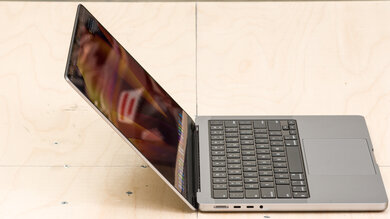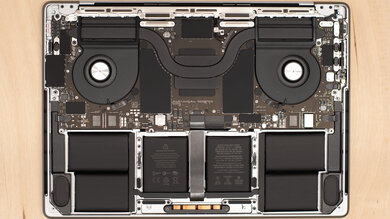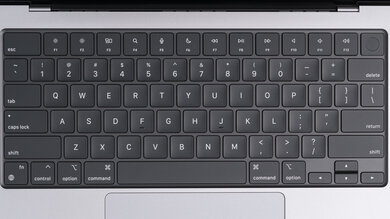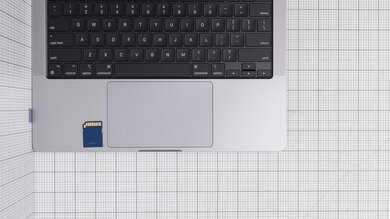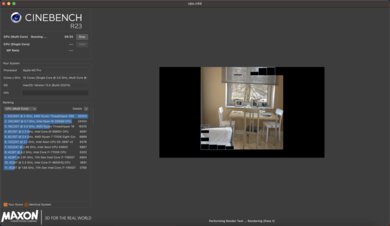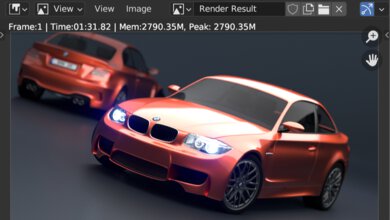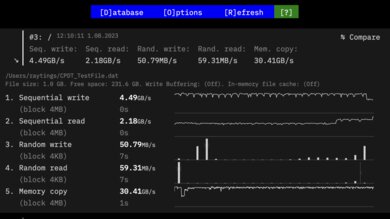The Apple MacBook Pro 14 (M2, 2023) is a high-end mobile workstation. It replaces the M1 Apple MacBook Pro 14 (2021). This 2023 model is identical to its predecessor in design, as the changes are all internal. The M2 Pro/Max SoCs have two additional efficiency CPU cores than the M1 Pro/Max chips and a higher GPU core count ranging from 16 to 38 (up from 14 to 32). Memory support has also increased, allowing up to 96GB of RAM on models with an M2 Max chip (up from 64GB). The only other upgrades are the addition of HDMI 2.1 and Wi-Fi 6E. It has the same 3024 x 1964 Mini LED display, fingerprint sensor, and 70Wh battery.
You can see our unit's specifications and the available configuration options in the Differences Between Variants section.
Our Verdict
The Apple MacBook Pro 14 is excellent for school use. It feels incredibly well-built, is portable, and lasts easily through a full school day on a full charge. The screen is sharp and bright, the keyboard feels spacious and tactile, and the touchpad is large and responsive. Its M2 Pro and M2 Max SoCs can handle nearly every type of workload, making it suitable for students in fields like 3D design, science and engineering, and filmmaking. It has an excellent 1080p webcam for those attending classes remotely and a wide port selection that includes three USB-C/Thunderbolt 4 and an HDMI 2.1 port.
- Easy to carry around.
- All-day battery life.
- Sharp, bright display.
- M2 Pro/Max SoC can handle demanding workloads.
- Tactile keyboard, large haptic touchpad.
- Keyboard gets hot under load.
The Apple MacBook Pro 14 is good for gaming. It has the processing power to provide smooth gameplay in demanding games; however, the performance will vary depending on the game, as most titles can only run via Rosetta 2 due to the lack of optimization for Macs with an ARM-based chip. Its Mini LED display's 120Hz refresh rate helps provide a responsive gaming experience, but its response time is very slow, leading to noticeable ghosting in fast-moving scenes. On the upside, it has a fast SSD to help shorten loading times and doesn't get overly hot or loud under load.
- M2 Pro/Max SoC can handle demanding workloads.
- 120Hz display.
- Fast storage drive.
- Display has slow response time, no VRR.
- Soldered RAM and storage drive.
- Few games optimized for Apple silicon.
- Keyboard gets hot under load.
The Apple MacBook Pro 14 is great for media consumption. It's very portable, and its battery lasts over nine hours of video playback, giving you plenty of time to get through a couple of full-length movies. Its Mini LED display looks incredibly sharp, gets bright enough for use outdoors, and produces inky blacks. Also, the display's color accuracy is superb out of the box, so you get an accurate and natural-looking image. The speakers sound well-balanced and full, and they get very loud with minimal compression at max volume.
- Easy to carry around.
- All-day battery life.
- Sharp, bright display.
- Display has full DCI P3 coverage.
- Loud speakers with full, well-balanced sound.
The Apple MacBook Pro 14 is an excellent workstation. The M2 Pro and M2 Max SoC can handle nearly every type of workload, including demanding tasks like video editing and 3D rendering. You can also do all of your color work, as the display has full DCI P3 coverage and superb factory calibration. There's no thermal throttling, and while the keyboard can get a little hot, the fans remain relatively quiet. Unfortunately, none of the components are user-replaceable, so you need to get the configuration that best suits your needs upfront.
- M2 Pro/Max SoC can handle demanding workloads.
- Tactile keyboard, large haptic touchpad.
- Display has full DCI P3 coverage.
- Fast storage drive.
- Soldered RAM and storage drive.
- Keyboard gets hot under load.
The Apple MacBook Pro 14 is great for business use. It's easy to carry, and its battery lasts over 11 hours of light use. It has a sharp, bright display, a comfortable keyboard, and a large, responsive touchpad. You get an excellent 1080p webcam for video calls and a fingerprint sensor to log in quickly. Its M2 Pro and M2 Max SoCs can easily handle productivity tasks like web browsing, text processing, spreadsheets, and presentations. You can even edit videos for your business. Unfortunately, none of the components are user-replaceable, and there's no USB-A port, so you'll need an adapter for your wired peripherals or dongles.
- Easy to carry around.
- All-day battery life.
- Sharp, bright display.
- Tactile keyboard, large haptic touchpad.
- Excellent 1080p webcam.
- Soldered RAM and storage drive.
Changelog
- Updated May 07, 2025: We've updated this review to Test Bench 0.8.3, which removes the viewing angle tests and adds a GPU Total Graphics Power comparison in the GPU section. The Pen Input test in the Extra Features section has also changed, as it now shows whether the laptop supports pen input rather than the inclusion of a stylus in the box. See the changelog for more details.
- Updated Jan 10, 2024: We've corrected a mistake in the Flicker section. The 'Active Below' should be 100% instead of 0% because the display flickers at all brightness levels.
- Updated Dec 19, 2023: Added mention of the Apple MacBook Pro 16 (M3, 2023) as an alternative with a bigger screen in the Screen Specs section.
- Updated Dec 07, 2023: Converted to Test Bench 0.8.2.
Differences Between Sizes And Variants
We tested the Apple MacBook Pro 14 2023 with an M2 Pro SoC (10-core CPU, 16-core GPU), 16GB of RAM, and 512GB of storage. The SoC, memory, and storage are configurable; the available options are in the table below.
| Screen |
|
|---|---|
| SoC |
|
| Memory |
|
| Storage |
|
| Color |
|
You can see our unit's label here.
Popular Laptop Comparisons
The Apple MacBook Pro 14 is among the best workstation laptops on the market. It stands out for its exceptional build, excellent performance, long battery life, and overall user experience. However, it's also one of the least user-upgradeable laptops because most components are soldered onto the motherboard.
For more options, see our recommendations for the best laptops, the best workstation laptops, and the best video editing laptops.
The Apple MacBook Pro 14 (M2, 2023) is a newer version of the Apple MacBook Pro 14 (M1, 2021). The 2023 model is slightly better due to some upgrades, including newer and faster M2 SoCs, increased memory support (up to 96GB), and HDMI 2.1. The M2 chips perform better overall but consume more power, leading to slightly shorter battery life on the newer model.
The Apple MacBook Pro 14 (M3, 2023) is a newer version of the Apple MacBook Pro 14 (M2, 2023). Except for a new Space Black color, the M3 model is identical to the M2 model in design, as the upgrades are internal. The M3 model has a slightly brighter display, longer battery life, and more configuration options, including a base M3 chip with 8 CPU and 10 GPU cores. The M3 chips bring better performance, as well as new features like hardware-accelerated ray tracing, AV1 decoding, and increased memory support up to 128GB.
While there are lots of similarities between the Apple MacBook Pro 14 (M2, 2023) and Apple MacBook Air 13 (M2, 2022), they're also very different, as the MacBook Pro is a mobile workstation designed for demanding workloads like video editing, while the MacBook Air is an ultraportable designed for light productivity tasks like text processing and web browsing. In addition to more processing power, the MacBook Pro has a nicer 120Hz Mini LED display, better-sounding speakers, and a wider port selection. It also has longer battery life, and unlike the MacBook Air, it supports multiple external displays. The MacBook Air is more portable, though, and unlike the MacBook Pro, it's a fanless device.
Although both laptops are 14-inch models, the Apple MacBook Pro 14 (M2, 2023) and the ASUS Zephyrus G14 (2024) are very different. The MacBook Pro is a mobile workstation and runs on macOS, while the ASUS is a Windows gaming laptop. The ASUS can also handle demanding tasks, but it isn't as ideal for highly intensive workloads requiring a lot of RAM, as it's only available with up to 32GB of memory. Also, you can only get up to 1TB of storage on the ASUS, so you'll have to upgrade the SSD yourself if you want more.
Test Results

The Apple MacBook Pro 14 looks exactly like its predecessor, the Apple MacBook Pro 14 (2021). It has a premium design with a full-aluminum chassis, thin bezels, and a gigantic glass touchpad. The notch is a matter of personal taste; you can hide it if it bothers you, though you'd lose the space beside it, which now houses the menu bar. There are vents on the bottom and at the back. It's available in two colors: Space Gray and Silver.
The Apple MacBook Pro 14 feels exceptionally well-built. It has a sturdy aluminum chassis that exhibits little to no flex on the lid, keyboard deck, and display. The finish doesn't easily scratch or smudge. The hinges, feet, and glass touchpad also feel solid. The device feels hefty, with evenly distributed weight. The only common complaint from user feedback is that the keycaps pick up oil and smudges very easily and develop a shine within only a few months of regular use, which is disappointing for such a premium device.
The internals are accessible the same way as the M1 Apple MacBook Pro 14 (2021). You need to remove eight P5 screws, pull the panel towards the bottom of the laptop, and then upwards to remove it completely. Unfortunately, the only user-replaceable part is the battery.
The Apple MacBook Pro 14's display looks very sharp due to its high pixel density. Its 16:10 aspect ratio is great for productivity, as it gives you more vertical space than a standard 16:9 screen, allowing you to see more information when reading a document without having to scroll. The downside is that you'll almost always have black bars at the top and bottom when watching standard 16:9 videos. The notch doesn't cut into the 16:10 display; instead, you get some extra space on each side of the notch where the menu bar now resides. If you need a bigger screen, get the Apple MacBook Pro 16 (M3, 2023).
The Apple MacBook Pro 14's display has a high refresh rate, which helps provide a more responsive, snappy desktop experience. ProMotion is a feature that allows the display to adjust the refresh rate dynamically; it ramps it up to 120Hz when scrolling or moving the cursor and ramps down to as low as 24Hz when the on-screen content is inactive to prolong battery life. Unfortunately, the response time is very slow, resulting in visible ghosting.
The Mini LED display's contrast ratio is superb. It's lower than the M1 Apple MacBook Pro 14 (2021), not because it's a different display but because the system treats the checkerboard pattern differently. The contrast is much higher at 50,350:1 when measuring a full white and full black screen in SDR. It's even higher in HDR at 1,100,000:1. Blacks look deep and inky. You may see some blooming around bright objects because the Mini LED backlight doesn't have pixel-level control like OLED panels.
The display's brightness is largely the same as the M1 Apple MacBook Pro 14 (2021) since it's the same display. It gets bright enough for use outdoors during the day, though you may still have trouble viewing some content in direct sunlight. It's very dim at the lowest brightness setting, which is great for dark room viewing, as it causes less eye strain.
The display's reflection handling is excellent. Its glossy finish performs well against bright ambient lighting but struggles with direct reflections, so it's best to avoid having bright lights shining at the screen.
The display's out-of-the-box accuracy is outstanding. All of the remaining inaccuracies are extremely minor and hard to spot. The color temperature is on the cooler side, but only by a tiny bit. This level of accuracy is suitable for color work like photo and video editing.
Unlike other laptop reviews, we've tested the MacBook Pro 14 and other MacBooks in the DCI P3 color space because the default color profile is in DCI P3. macOS usually limits the color reproduction to sRGB when showing sRGB content to avoid oversaturation and other inaccuracies; however, it doesn't do so with the signal from Calman, the software we use to measure the display. Evaluating the P3 color profile in sRGB would lead to a high color dE, which isn't representative of the real-world user experience, as the display is very accurate, even when viewing sRGB content with the system's color profile set to Apple Display (P3, 500 nits). macOS has multiple color profiles, including a pure sRGB option; here are the measurements in the sRGB mode:
- Average White Balance dE: 1.98
- Average Gamma: 2.20
- Average Color dE: 1.28
- Average Color Temperature: 6869.4
The display's color gamut is outstanding. It has full sRGB coverage, meaning it can display all the colors used in most online content. It also has full DCI P3 coverage, making it suitable for viewing and producing HDR content. Its Adobe RGB coverage is excellent, but it might not be wide enough for professional print photography, as it's missing the saturated greens that define Adobe RGB.
The Apple MacBook Pro 14 2023 has a great keyboard. The layout feels spacious and is exactly like all other MacBooks, so if you've used a Mac before, it won't take long to get used to it. The keys are stable, don't require much force to actuate, and provide good tactile feedback. However, their travel distance is very short, which some people might not like as it's easy to bottom out. Typing noise is very low and isn't a problem in quiet environments. You can adjust the backlight brightness via the control panel or settings.
The touchpad is outstanding. Apple's touchpads are practically the gold standard these days, and this is no different. It's large, responsive, and easy to use. It tracks all movements and gestures well, and there's no issue with palm rejection. Like other MacBooks, it uses a haptic engine to simulate the clicks instead of physical buttons, allowing you to click anywhere on the touchpad.
The speakers get very loud with minimal compression artifacts at max volume. They sound full and natural, with a good amount of bass. They're easily among the best speakers on the market.
The webcam's video quality is outstanding. The image looks detailed well-exposed, and natural. Voices come across loud and clear, with no background noise.
The port selection is excellent. The three USB-C ports support Thunderbolt 4 (up to 40Gbps data transfer rate and two 4k displays at 60Hz), USB4, charging, and DisplayPort. External monitor support changes depending on the SoC. The M2 Pro supports up to two 6k displays at 60Hz over Thunderbolt, or one 6k 60Hz display over Thunderbolt and one 4k 144Hz display over HDMI. Alternatively, it can support one 8k 60Hz or 4k 240Hz display over HDMI. The M2 Max supports up to three 6k displays at 60Hz over Thunderbolt and one 4k 144Hz display over HDMI or two 6k 60Hz displays over Thunderbolt and one 4k 240Hz (or 8k at 60Hz) over HDMI.
We can't confirm which wireless adapter the Apple MacBook Pro 14 2023 uses.
The Apple MacBook Pro 14 2023 is available with the following SoCs:
- M2 Pro 10-core CPU, 16-core GPU, 200GB/s memory bandwidth
- M2 Pro 12-core CPU, 19-core GPU, 200GB/s memory bandwidth
- M2 Max 12-core CPU, 30-core GPU, 400GB/s memory bandwidth
- M2 Max 12-core CPU, 38-core GPU, 400GB/s memory bandwidth
The M2 Pro and Max chips are essentially the same SoCs as the M1 Pro and Max. The core count has increased with the addition of two efficiency cores; the number of performance cores and the memory bandwidth are the same as the M1 chips. The 10-core CPU now has six performance and four efficiency cores, while the 12-core CPU has eight and four.
Performance-wise, the M2 Pro and Max SoCs can handle nearly every type of workload, from simple web browsing to demanding video editing tasks. Single-thread performance is the same no matter which SoC you choose; however, multi-thread performance will be better on chips with a 12-core CPU. Choosing between the 10- and 12-core CPU will depend on your workload and whether the applications you use can take advantage of the wider memory bandwidth.
As noted in the CPU section above, you can get the M2 Pro/Max SoC with a 16-, 19-, 30-, or 38-core GPU. Our unit has the base configuration with 16 cores. The GPU shares the same memory pool as the CPU, but unlike most integrated graphics, it can use as much of the shared memory as it needs. Regarding the media engines, the Pro chips have one video and one ProRes (decode and encode) engine. In contrast, the Max chips have two of each, providing better performance in video editing and image rendering tasks. Choosing between these SoCs will depend on your usage. The base configuration can handle most workloads, though the higher configurations will provide a smoother experience in more demanding tasks and complete jobs faster.
As for gaming, the M2 Pro with 16 GPU cores can handle demanding titles, but you'll almost certainly have to play at 1080p with medium to low graphical settings to achieve playable frame rates. The top-end M2 Max with 38 GPU cores can handle more demanding games and run some at 1440p. That said, gaming performance can vary significantly depending on whether the game runs natively or through Rosetta 2, as the latter can cause a drop in performance or graphical glitches. Games included in Apple's Arcade subscription service will run well because they're mobile games designed for ARM-based SoCs.
You can configure this laptop with 16GB, 32GB, 64GB, or 96GB of RAM. However, the 64GB and 96GB options are only available if you upgrade the SoC to an M2 Max. The memory isn't user-replaceable.
You can configure the M2 Apple MacBook Pro 14 with 512GB, 1TB, 2TB, 4TB, or 8TB of storage. The 512GB configuration has a single NAND chip, resulting in a slower sequential read speed, so it's best to upgrade to a larger-capacity option if read speed is important for your workload. The storage drive isn't user-replaceable.
The Apple MacBook Pro 14 2023 with an M2 Pro (10-core GPU) SoC performs exceptionally well in the Geekbench 5 benchmarks, indicating that it can handle nearly every type of workload, including light productivity tasks like text processing and web browsing and more demanding workloads like programming, video editing, and simulations. The M2 Pro/Max SoCs with a 12-core CPU will perform better as they have two additional performance cores. As for GPU computing tasks, the base M2 Pro SoC with 16 GPU cores performs well and can handle most workloads. Upgrading to the SoCs with more GPU cores will improve graphical performance, but the media engines do most of the heavy lifting in tasks that can utilize them, so the GPU compute score isn't fully representative of the SoC's performance.
The Apple MacBook Pro 14 2023's base M2 Pro chip performs exceptionally well in the Cinebench R23 benchmark. All of the M2 Pro/Max chips are suitable for 3D image rendering and other related workloads. The 12-core SoC will perform better, but not by a significant amount.
The Apple MacBook Pro 14 2023's performance in Blender is outstanding. Although the CPU can render images relatively quickly, rendering with the GPU is much faster. The other M2 Pro/Max SoCs with more GPU cores will perform even better, with the top-end M2 Max (38-core GPU) likely taking only seconds to render the same scene.
The M2 Pro SoC with a 16-core GPU scores well compared to integrated graphics, but its performance is relatively low compared to discrete GPUs. This level of performance is roughly equivalent to an NVIDIA GeForce RTX 3050 Ti, a gaming GPU designed for 1080p gaming. The other M2 Pro/Max chips with more GPU cores will perform better, with the top-end 38-core M2 Max capable of handling AAA games at 1440p. That said, performance will vary depending on each game's optimization, as very few titles run natively on Apple silicon.
The storage drive performance is outstanding. Its fast read and write speeds allow the system to quickly boot up, launch apps, and transfer files. The sequential read speed is lower than expected because the 512GB storage option has a single NAND chip, as you can see in this photo comparing the newer model (left) to the older M1 Apple MacBook Pro 14 (2021). The slower speed is unlikely to be noticeable in everyday use. If your workload requires retrieving large data sets from the drive, you probably need a lot of storage space anyway, so it's worth upgrading to one of the larger-capacity options, which are faster because they have two NAND chips.
The Apple MacBook Pro 14 2023's battery life is outstanding. It lasts easily through a typical workday of light use on a full charge. You can expect roughly the same battery life as gaming if you have a more intensive workload that stresses the CPU or GPU. Models with more CPU or GPU cores will likely have slightly shorter battery life.
Borderlands 3 runs poorly. The average frame rate is too low with high settings, and there are frequent stutters due to frame drops. You can get over 60 fps with low settings, but the game still stutters. While the M2 Max SoCs with more GPU cores will push higher frame rates, you'll likely still experience regular stutters. You can expect the same performance in other similar titles.
Civilization VI runs decently well. While it isn't necessary to reach 60 fps to play this type of strategy game, you can easily push over 60 fps if you lower a couple of settings. The turn time is slow, but it doesn't truly indicate the SoC's performance. It's likely the result of having to run the game via Rosetta 2 since the game doesn't support Apple silicon. Upgrading to the 12-core CPU will only improve the turn time slightly.
The Apple MacBook Pro 14 2023 can handle Shadow of the Tomb Raider and other similar AAA titles. The gameplay is fairly smooth at 1080p with high settings; there are only a few stutters. You can get much smoother gameplay by turning down a few graphical settings. The M2 Pro/Max SoCs with more GPU cores will easily push over 60 fps with high settings.
The keyboard deck is cool when idle; however, it gets quite warm under load and can cause discomfort as the hottest spot is right in the middle of the keyboard. The fans are relatively quiet at full speed and aren't bothersome.
The Apple MacBook Pro 14 2023's performance over time is superb—neither the CPU nor the GPU throttles despite their high temperatures.
The Apple MacBook Pro 14 2023 has no pre-installed applications besides those that typically come with macOS.
The Apple MacBook Pro 14 2023 has a fingerprint sensor built into the power button. You can use it to log in quickly, authorize purchases in the Apple App Store, use Apple Pay, and auto-fill saved passwords on supported websites.



